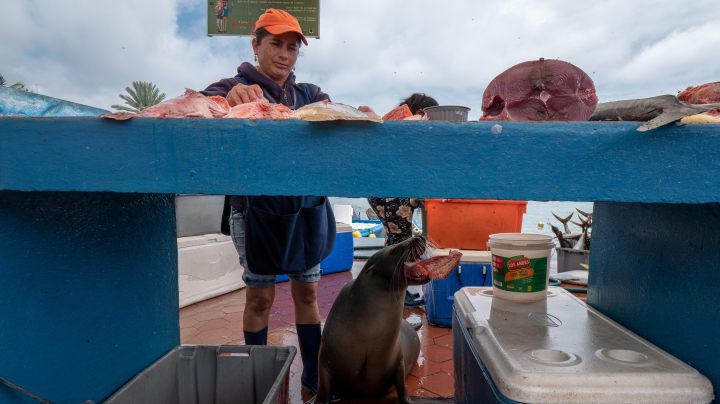Ecuador’s Galapagos Islands Fight to Survive & Adapt in the Time of Coronavirus

A Sea lion eats a piece of fish given to it as a woman works at the fish market in Puerto Ayora on Santa Cruz island on January 18, 2019 in Galapago Islands, Ecuador. Photo by Chris J Ratcliffe/Getty Images
Ecuador is facing many challenges, including the fight for its famed Galapagos islands.
The South American country has been battered by the spread of the coronavirus. More than 2,338 people have died, according to government tallies, and the country has struggled to keep up with the surging number of patients. Last month, reports surfaced of officials having to pivot resources and scramble to find funeral and burial spaces to address a mounting death count, sometimes leaving family members waiting at home with the bodies of their loved ones.
The focus now is on getting a handle on contagion, but Ecuador still has challenges ahead—including vulnerable regions like the Galapagos. The beloved archipelago, popularized by the research of Charles Darwin and his theory of evolution, isn’t equipped to deal with the virus. The Associated Press reports that its hospitals didn’t have a single intensive care unit bed before the pandemic since life-threatening diseases among its communities of tourists, fishermen and locals were rare.
But COVID-19 has already arrived on the islands; the first four cases were diagnosed in March and now there are about 107 total. For the most part, these cases have been mild; there have been no deaths on the island and only two people have been hospitalized. Still, the government is urgently expanding hospital capacity, which right previously meant there were only four ICU beds for every 7,500 residents. They’re also planning to add a lab on the island for tests. This marks big changes for how things operate in the region. As the AP notes, islanders previously used military aircraft to get critically ill people to Quito or Guayaquil, both cities with high contagion.

“Galapagos is the land of evolution,” Joseline Cardoso, a hotel owner on Santa Cruz island told the AP. “The animals have adapted, and we humans cannot be the exception.”
People who live on the islands have been limiting trips to the mainland and instead focusing on growing produce for food. Cargo ships that transported items back and forth have been much slower to arrive and tourism, one of the biggest economic drivers in the region, has halted.
“The base of our economy has entirely collapsed,” Norman Wray, governor of the islands, told the AP. “This is completely changing the future of tourism in the Galapagos.”